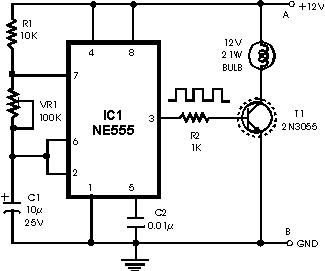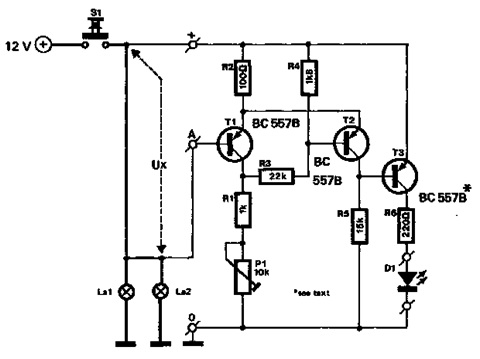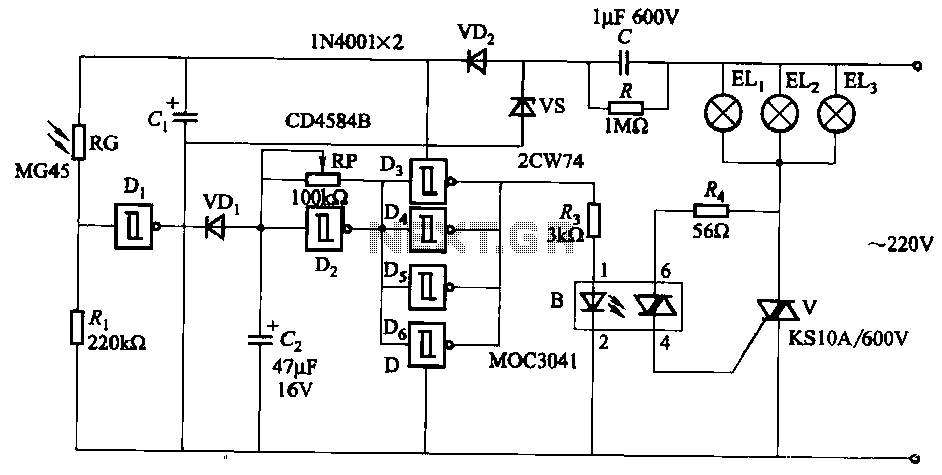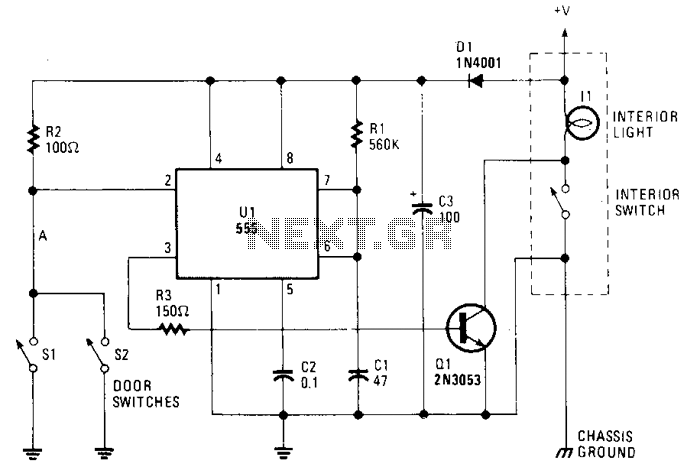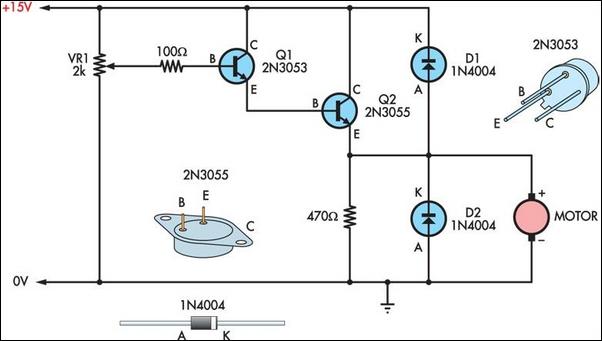
Speed of Light with Nanosecond Pulsed 650 nm Diode Laser
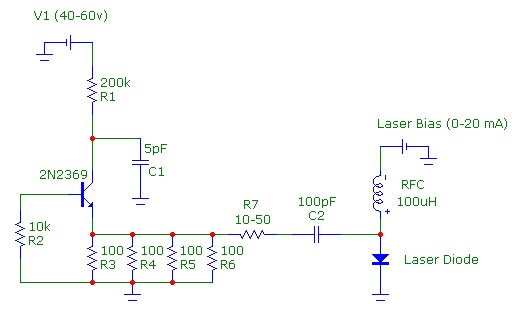
The speed of light has been measured using various ingenious methods. This note describes a conceptually simple and relatively easy-to-implement technique known as the time-of-flight optical pulse delay method. It utilizes a short (nanosecond) optical pulse and an oscilloscope with a bandwidth between 50 - 100 MHz. Common low-power laser pointers, typically emitting at a wavelength of 650 nm, operate from two to four 1.5 V button cells. These lasers can often be extracted from their assemblies and pulse-modulated to several hundred megahertz. The laser employed in this method was taken from a low-power (< 5mW) laser pointer assembly from a popular retail outlet. It is pre-biased below the threshold at a current of 5 - 10 mA (the threshold current for this laser is 24 mA) using an inductor as a bias insertion element. A short (< 5 ns) electrical pulse modulates the laser. Due to the low duty cycle used for pulsing, high current pulses can be achieved without damaging the laser. The forward current and voltage during the drive pulse depend on the I-V characteristics of the specific laser but typically range from 50 - 100 mA and 6 - 10 V, respectively. The short electrical pulse is generated using a simple avalanche transistor circuit. The high frequency of the pulse means that the current pulse shape driving the laser will depend on circuit components (such as series resistors) and parasitic effects (like series inductance of connection wires). This circuit has been documented by Jim Williams in the Linear Technology Measurement and Control Circuit Collection and has multiple applications. A suitable avalanche transistor for this purpose is the 2N2369 NPN switching transistor, which is available at a low cost. The optical pulse delay is measured using a high-speed Si pin detector (ThorLabs PDA 10A, 150 MHz bandwidth) to compare the signal reflected from a beam splitter close to the laser and the path-delayed signal (the time delay is determined by the distance of the mirrors). A 100 MHz oscilloscope was used to resolve the time delay of the two signals. High-speed Si pin detectors are widely available from various suppliers at low cost. The overall setup includes mirrors, the laser, the drive circuit, and the detection circuit. The measured pulse delay corresponds to the optical path delay between the two paths. A close-up of the avalanche transistor driver circuit shows the laser diode (at the top) with bias (left) and pulse (right) connections. This setup, which is intended for quickly evaluating different diodes and circuit elements, should be properly packaged with good RF design practices (short leads, proper ground connections, etc.). However, the requirements for measuring the speed of light do not necessitate excessive attention to final circuit implementation. The schematic diagram illustrates the avalanche-pulse generation circuit and the laser-diode connection. With typical values, a pulse width of 500 ps - 1 ns can be achieved, determined by the collector capacitor C1 and the total emitter load resistance (typically 10 - 20 ohms). C1 should be kept below 15 pF to ensure short pulses. The transistor must exhibit avalanche breakdown behavior, such as the 2N2369. The power supply V1 for the transistor should be adjusted until avalanching just begins (typically around 50 V for the 2N2369). Basic suggestions for simple power supply options are provided. The pulse repetition rate is governed by the RC time constant of the collector resistor R1 and C1, where R1 can range from 200 kΩ to 1 MΩ. The four emitter resistors in parallel (R3-R6) help reduce parasitic inductance. R7 should be adjusted to limit the current supplied to the laser during the pulse. All components C1, C2, R2-R7 should be soldered close together.
The described circuit utilizes a time-of-flight measurement technique to ascertain the speed of light by employing a pulsed laser and advanced detection methods. The laser diode, selected for its low output power and ability to be modulated, is driven by an avalanche transistor configured to generate short electrical pulses. The choice of the 2N2369 transistor is crucial, as it allows for avalanche breakdown, enabling the generation of high-frequency pulses necessary for precise measurements. The circuit design emphasizes minimizing parasitic inductance and capacitance to maintain the integrity of the pulse shape, which is vital for accurate time delay measurements.
The setup includes a beam splitter that directs the laser light along two paths, one of which is delayed by a known distance. The reflected signals are captured by a high-speed Si pin detector, which converts the optical signals back into electrical signals for analysis. The oscilloscope is used to visualize the time delay between the two signals, allowing for the calculation of the speed of light based on the known distance and the measured time delay.
In practice, careful attention should be given to the layout of the components to ensure minimal interference and signal degradation. Short connections, proper grounding, and the use of high-quality components will enhance the reliability and accuracy of the measurements. This circuit not only serves the purpose of measuring the speed of light but can also be adapted for various applications in optical communications and high-speed signal processing, showcasing its versatility in the field of electronics.The speed of light has been measured many different ways using many ingenious methods. The following note describes a method which is conceptually very easy to understand and fairly easy to implement. The technique is the simple time-of-flight optical pulse delay method using a fairly short (nanosecond) optical pulse and an oscilloscope with bandw
idth between 50 - 100 MHz. Common low power laser pointers, typically emit at a wavelength of 650 nm and operate from two to four 1. 5 V button cells. Many of these lasers can be easily extracted from the pointer assembly and pulse-modulated to several hundred megahertz.
The laser used here was removed from a low power (< 5mW) laser pointer assembly from a popular retail outlet. The laser is prebiased below threshold, at 5 - 10 mA current (threshold current for the laser used here is 24 mA) using an inductor as a bias insertion element.
A short (< 5 ns) electrical pulse modulates the laser. Since a very low duty cycle is used for pulsing the laser, fairly high current pulses are possible without degrading the laser. The actual forward current and voltage achieved during the drive pulse are dependent on the details of the I-V characteristic of the specific laser used, but are typically in the range of 50 - 100 mA and 6 - 10 V respectively.
The short electrical pulse is generated using a simple avalanche transistor circuit. Due to the high frequency content of the short pulse, the actual shape of the current pulse driving the laser will depend on the circuit components (series resistors etc. ) and parasitic electrical effects (series inductance of connection wires etc. ) The circuit has been described by Jim Williams in a Linear Technology Measurement and Control Circuit Collection and has many other uses.
A suitable choice for the avalanche transistor is the 2N2369 NPN switching transistor, available at low cost from Electronix Express. The optical pulse delay between the signal reflected from a beam-splitter close to the laser and the path-delayed signal (time delay determined by mirror distances) is measured using a high-speed Si pin detector (ThorLabs PDA 10A 150 MHz BW).
In this setup, a 100 MHz oscilloscope was used to resolve the time delay of the two signals. Sufficiently high-speed Si pin detectors are readily available from many different suppliers at low cost. The overall setup showing mirrors, laser, drive circuit and detection circuit. The pulse delay measured corresponds to the optical path delay between the two paths: Closeup of the avalanche transistor driver circuit, laser diode (at top) with bias (left) and pulse (right) connections.
This setup, used to quickly evaluate different diodes and circuit elements, should be properly packaged with good rf-design (short leads, good ground connections etc. ). However, the requirements for measuring the speed of light do not require excessive attention to final circuit implementation.
Schematic diagram of avalanche-pulse generation circuit and laser-diode connection. With these typical values, a pulse width of 500ps - 1ns is achieveable. The pulse width is determined by the collector capacitor C1 and the total emitter load resistance (typically 10 - 20 ohm). C1 should be kept below 15 pF to achieve short pulses. The transistor must be one exhibiting avalanche breakdown behaviour such as the 2N2369. The transistor power supply V1 should be adjusted until avalanching just starts (typically around 50 V for the 2N2369).
(Some basic suggestions on simple power supply possibilities are given below). The pulse repetition rate is determined by the RC time constant of the collector resistor R1 and C1. R1 generally can be any value from 200 kohm to 1 Mohm. The four emitter resistors in parallel (R3-R6) reduce parasitic inductance. R7 should be adjusted to limit the current provided to the laser during the pulse. All components C1, C2, R2-R7 should be soldered as close togethe 🔗 External reference
The described circuit utilizes a time-of-flight measurement technique to ascertain the speed of light by employing a pulsed laser and advanced detection methods. The laser diode, selected for its low output power and ability to be modulated, is driven by an avalanche transistor configured to generate short electrical pulses. The choice of the 2N2369 transistor is crucial, as it allows for avalanche breakdown, enabling the generation of high-frequency pulses necessary for precise measurements. The circuit design emphasizes minimizing parasitic inductance and capacitance to maintain the integrity of the pulse shape, which is vital for accurate time delay measurements.
The setup includes a beam splitter that directs the laser light along two paths, one of which is delayed by a known distance. The reflected signals are captured by a high-speed Si pin detector, which converts the optical signals back into electrical signals for analysis. The oscilloscope is used to visualize the time delay between the two signals, allowing for the calculation of the speed of light based on the known distance and the measured time delay.
In practice, careful attention should be given to the layout of the components to ensure minimal interference and signal degradation. Short connections, proper grounding, and the use of high-quality components will enhance the reliability and accuracy of the measurements. This circuit not only serves the purpose of measuring the speed of light but can also be adapted for various applications in optical communications and high-speed signal processing, showcasing its versatility in the field of electronics.The speed of light has been measured many different ways using many ingenious methods. The following note describes a method which is conceptually very easy to understand and fairly easy to implement. The technique is the simple time-of-flight optical pulse delay method using a fairly short (nanosecond) optical pulse and an oscilloscope with bandw
idth between 50 - 100 MHz. Common low power laser pointers, typically emit at a wavelength of 650 nm and operate from two to four 1. 5 V button cells. Many of these lasers can be easily extracted from the pointer assembly and pulse-modulated to several hundred megahertz.
The laser used here was removed from a low power (< 5mW) laser pointer assembly from a popular retail outlet. The laser is prebiased below threshold, at 5 - 10 mA current (threshold current for the laser used here is 24 mA) using an inductor as a bias insertion element.
A short (< 5 ns) electrical pulse modulates the laser. Since a very low duty cycle is used for pulsing the laser, fairly high current pulses are possible without degrading the laser. The actual forward current and voltage achieved during the drive pulse are dependent on the details of the I-V characteristic of the specific laser used, but are typically in the range of 50 - 100 mA and 6 - 10 V respectively.
The short electrical pulse is generated using a simple avalanche transistor circuit. Due to the high frequency content of the short pulse, the actual shape of the current pulse driving the laser will depend on the circuit components (series resistors etc. ) and parasitic electrical effects (series inductance of connection wires etc. ) The circuit has been described by Jim Williams in a Linear Technology Measurement and Control Circuit Collection and has many other uses.
A suitable choice for the avalanche transistor is the 2N2369 NPN switching transistor, available at low cost from Electronix Express. The optical pulse delay between the signal reflected from a beam-splitter close to the laser and the path-delayed signal (time delay determined by mirror distances) is measured using a high-speed Si pin detector (ThorLabs PDA 10A 150 MHz BW).
In this setup, a 100 MHz oscilloscope was used to resolve the time delay of the two signals. Sufficiently high-speed Si pin detectors are readily available from many different suppliers at low cost. The overall setup showing mirrors, laser, drive circuit and detection circuit. The pulse delay measured corresponds to the optical path delay between the two paths: Closeup of the avalanche transistor driver circuit, laser diode (at top) with bias (left) and pulse (right) connections.
This setup, used to quickly evaluate different diodes and circuit elements, should be properly packaged with good rf-design (short leads, good ground connections etc. ). However, the requirements for measuring the speed of light do not require excessive attention to final circuit implementation.
Schematic diagram of avalanche-pulse generation circuit and laser-diode connection. With these typical values, a pulse width of 500ps - 1ns is achieveable. The pulse width is determined by the collector capacitor C1 and the total emitter load resistance (typically 10 - 20 ohm). C1 should be kept below 15 pF to achieve short pulses. The transistor must be one exhibiting avalanche breakdown behaviour such as the 2N2369. The transistor power supply V1 should be adjusted until avalanching just starts (typically around 50 V for the 2N2369).
(Some basic suggestions on simple power supply possibilities are given below). The pulse repetition rate is determined by the RC time constant of the collector resistor R1 and C1. R1 generally can be any value from 200 kohm to 1 Mohm. The four emitter resistors in parallel (R3-R6) reduce parasitic inductance. R7 should be adjusted to limit the current provided to the laser during the pulse. All components C1, C2, R2-R7 should be soldered as close togethe 🔗 External reference
Warning: include(partials/cookie-banner.php): Failed to open stream: Permission denied in /var/www/html/nextgr/view-circuit.php on line 713
Warning: include(): Failed opening 'partials/cookie-banner.php' for inclusion (include_path='.:/usr/share/php') in /var/www/html/nextgr/view-circuit.php on line 713
